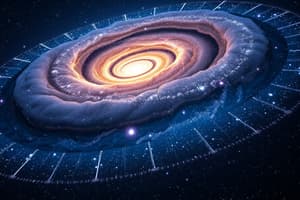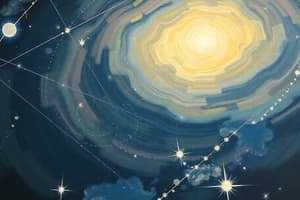Podcast
Questions and Answers
Who proposed the Steady State Theory in the 1940s?
Who proposed the Steady State Theory in the 1940s?
- Edwin Hubble
- Albert Einstein
- Sir Fred Hoyle (correct)
- Stephen Hawking
What does the Steady State Theory suggest about the universe?
What does the Steady State Theory suggest about the universe?
- It had a definite starting point
- It is constantly shrinking
- It is a closed system
- It is infinite with no beginning or end (correct)
What is one reason the Steady State Theory is largely discredited today?
What is one reason the Steady State Theory is largely discredited today?
- It contradicts the laws of thermodynamics
- It is unable to explain certain evidence gathered by cosmologists (correct)
- It lacks a famous proponent
- It is too complex for modern understanding
What was Sir Fred Hoyle's big contribution to the development of the theory of nucleosynthesis?
What was Sir Fred Hoyle's big contribution to the development of the theory of nucleosynthesis?
What is nucleosynthesis?
What is nucleosynthesis?
Flashcards are hidden until you start studying
Study Notes
Steady State Theory
- Proposed by astronomers Fred Hoyle, Thomas Gold, and Hermann Bondi in the 1940s.
- Suggests that the universe is eternal and expanding, maintaining a constant average density by the continuous creation of matter.
Discrediting the Theory
- Largely discredited due to the discovery of cosmic microwave background radiation, which supports the Big Bang Theory instead.
- Observations of distant galaxies and their redshifts provide evidence for the universe's expansion from a hot, dense state.
Contribution of Sir Fred Hoyle
- Instrumental in the development of the theory of nucleosynthesis, which explains the formation of new atomic nuclei in stars.
- Coined the term "Big Bang" ironically while discussing his steady state ideas, emphasizing the contrast between the two theories.
Nucleosynthesis
- Refers to the process by which new elements are formed from nuclear reactions, primarily occurring in stars.
- Involves both primordial nucleosynthesis (formation of elements shortly after the Big Bang) and stellar nucleosynthesis (creation of heavier elements within stars during their life cycles).
Studying That Suits You
Use AI to generate personalized quizzes and flashcards to suit your learning preferences.




